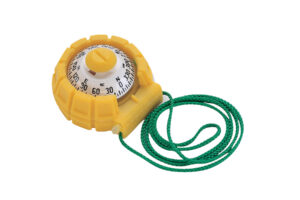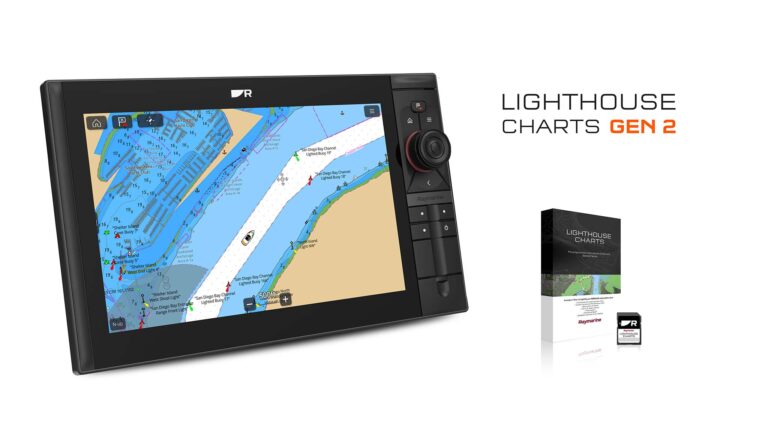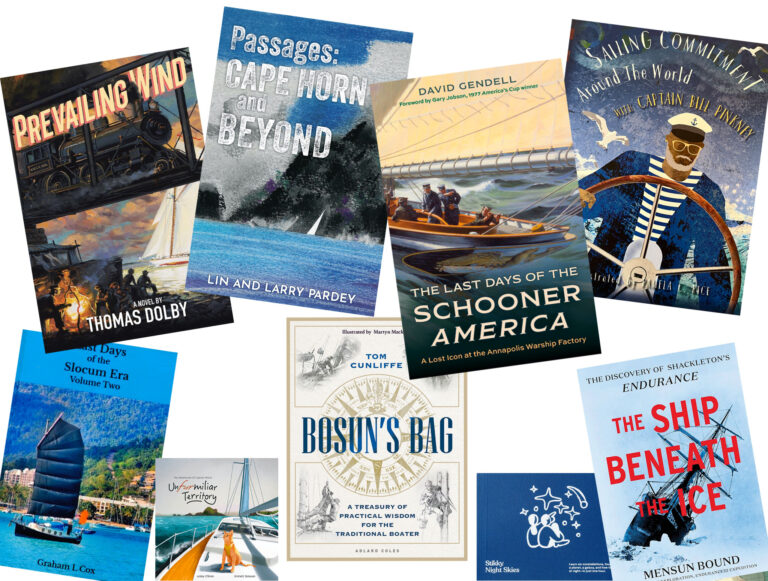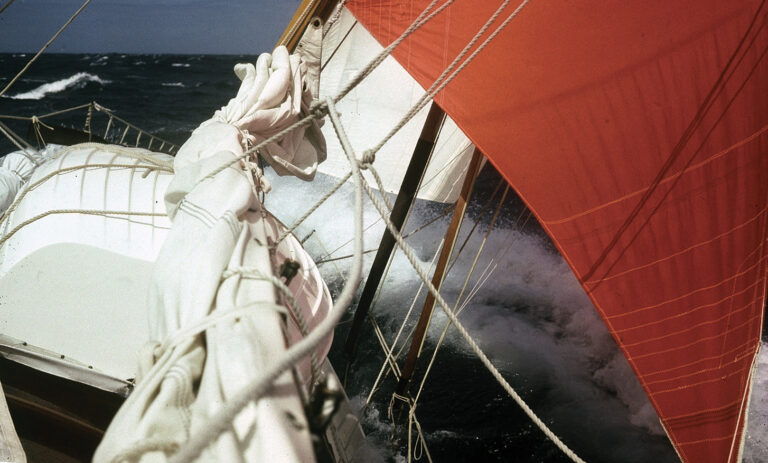
Windward Passage
A Maxi Yacht in Her Sixth Decade
By Randall Peffer, Steve Jost, Ronald Geisman
WoodenBoat, $75.00
Few world class racing boats have had such improbable beginnings as Windward Passage—conceived by a somewhat renegade logger-entrepreneur-sailor, drawn by an untested young designer, built by a scrum of footloose “sailorboys” out of cold-molded spruce on the edge of a Bahamian harbor under not much more than a tent.
And few world class racing boats have had the equally improbable life that followed—sailing hundreds of thousands of ocean miles chasing regattas around the world, setting a multitude of records, furiously vexing younger, fancier competitors even after nearly 20 years of hard racing, and going on to gain a new lease on life as a luxurious, fast, world-traveling cruising yacht that still drops jaws wherever she goes.
Conceived by “Big” Bob Johnson and designed by Alan Gurney, this 73-footer seemed bound to become a legend from her launch in 1968, and it’s this destiny and history that makes Windward Passage A Maxi Yacht in Her Sixth Decade, much more than a typical coffee table tome. Randall Peffer, who wrote a story about the yacht in the May/June 2021 issue of WoodenBoat, joined forces with photographer Steve Jost and designer Ronald Geisman to produce this love song to a sailboat like no other. But while celebrating the boat, it’s also about the people who have sailed her, loved her, and cared for her through the decades and over the countless ocean miles.
The stories flow from interviews with former and current owners, captains, and crew, and the visuals are equally compelling, with many of the most stunning photos taken by yachting photographer Phil Uhl when Passage was at the height of her racing career in the 1970s and ’80s. The preposterous acreage of canvas carried by maxi yachts at that time made them impossibly photogenic, not to mention frequently wild to sail.
A terrific description of her came in a story from one of her first races, the 1969 SORC’s Miami-Nassau Race, when high winds and seas pummeled the fleet of more than 100 boats in what a Nassau newspaper called “a night of terror.” The book quotes sailor and author Robert Rubadeau, “who was on watch that evening aboard another racer surging through the dark toward Great Stirrup Cay. ‘This great white phantom blew by me like an express train, just a few yards to leeward,’ says Rubadeau. ‘It was Passage. She was there and gone before I even had time to be scared she might hit us.’ ’’
That night, Windward Passage set a record time of 15 hours, 54 minutes, 17 seconds, beating the previous record by nearly three hours. It was the first of many she would crush throughout her career.
One of the most wonderful aspects of her story is that it could happen at all. But she came to be in a time when yacht racing was still a Corinthian sport, before it became entirely professional, corporate, and prohibitively expensive, and the book is as much a paean to the boat as to that era and the sailors who rambled the planet living in it. During these years, boats still sailed oceans to make a starting line—by 1993, Passage had transited the Panama Canal 12 times already—rather than being packed up and moved on a ship. The bluewater miles these boats and crew traveled as a matter of course are inconceivable to most sailors today.
For instance, the racing schedule in 1972 had them starting in Long Beach, California, then to Acapulco, through the canal and up to Newport, Rhode Island, for the Bermuda Race, followed by a translatlantic from Bermuda to Spain. “Those events added up to 6,000 miles of racing and a 25,000-mile voyage for the yachts to make the round trip back to California.” That was just one season. The people who sailed Passage through these miles in all weather were not just racers; they were self-sufficient mariners capable of dealing with everything from jury-rigging a broken mast to dodging a hurricane.
Passage’s storied history is part of what has enabled her survival into six decades. Designers like Doug Peterson were only too happy to draw her a new keel and rudder in the early 1980s to make her lighter and faster; owners through the years understood that they were curating a legend, not just upgrading a boat.
She was, says WoodenBoat’s Matthew Murphy in the introduction, “one of the most influential wooden ocean racers ever to roam the planet.” You could drop the adjective wooden, and the statement would still be true.









